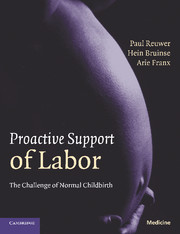Book contents
- Frontmatter
- Contents
- Foreword
- Acknowledgments
- Web-Forum
- 1 General introduction
- Section 1 A wake-up call
- Section 2 Back to basics
- Section 3 Proactive support of labor
- 12 Introductory synopsis
- 13 Nulliparous versus parous labor
- 14 Diagnosis of labor
- 15 Prevention of long labor
- 16 Personal continuity and continuous support
- 17 Amniotomy and oxytocin
- 18 Labor pain in broader perspective
- 19 Prelabor preparation
- 20 Medical pain relief revisited
- 21 Dynamic dystocia unraveled
- 22 Mechanical birth obstruction
- 23 Curtailed use of induction
- 24 Intrapartum care of the fetus
- 25 Prevention of litigation
- 26 Organizational reforms
- 27 Continual audit and feedback
- 28 Quality assessment
- 29 Hospital statistics
- 30 Sum of the parts
- Index
- References
17 - Amniotomy and oxytocin
Published online by Cambridge University Press: 08 September 2009
- Frontmatter
- Contents
- Foreword
- Acknowledgments
- Web-Forum
- 1 General introduction
- Section 1 A wake-up call
- Section 2 Back to basics
- Section 3 Proactive support of labor
- 12 Introductory synopsis
- 13 Nulliparous versus parous labor
- 14 Diagnosis of labor
- 15 Prevention of long labor
- 16 Personal continuity and continuous support
- 17 Amniotomy and oxytocin
- 18 Labor pain in broader perspective
- 19 Prelabor preparation
- 20 Medical pain relief revisited
- 21 Dynamic dystocia unraveled
- 22 Mechanical birth obstruction
- 23 Curtailed use of induction
- 24 Intrapartum care of the fetus
- 25 Prevention of litigation
- 26 Organizational reforms
- 27 Continual audit and feedback
- 28 Quality assessment
- 29 Hospital statistics
- 30 Sum of the parts
- Index
- References
Summary
Clinical practice with regard to augmentation of labor is often difficult to comprehend. In many maternity units there is no protocol for the diagnosis and treatment of slow labor and each physician seems to have fixed preferences for which there is no factual basis. In effect, some obstetricians criticize midwives or residents for rupturing the membranes (especially late in the evening), whereas others criticize those who dare to consult them for slow labor when the membranes are still intact. Timing and dosage of oxytocin treatment also vary widely. While some obstetricians forbid any measures in the alleged “latent phase of labor,” others order the administration of oxytocin without prior amniotomy. One consultant may feel that an IV drip with 2.5 U of oxytocin best accelerates labor, whereas another may prefer to use 5 U and yet another 10 U. To complicate matters even further, some doctors use all three doses consecutively on the same woman. No wonder residents and nurses become utterly confused. In such capricious circumstances, mistakes are bound to happen. Clearly, high-quality care demands an overall plan and explicit rules for the timing and execution of augmentation of labor, and criticism should be directed toward those who do not comply.
The truth about amniotomy
Although amniotomy is among the most commonly performed procedures in obstetrics, there is a lack of reliable data on this issue. The literature is confusing because amniotomy cannot be studied in isolation.
- Type
- Chapter
- Information
- Proactive Support of LaborThe Challenge of Normal Childbirth, pp. 138 - 149Publisher: Cambridge University PressPrint publication year: 2009



